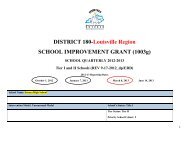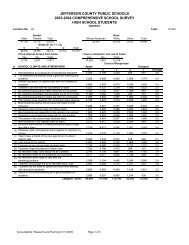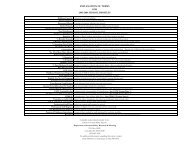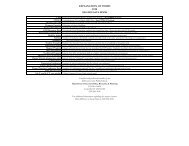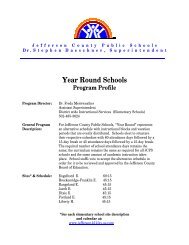The EE Sampler - Jefferson County Public Schools
The EE Sampler - Jefferson County Public Schools
The EE Sampler - Jefferson County Public Schools
You also want an ePaper? Increase the reach of your titles
YUMPU automatically turns print PDFs into web optimized ePapers that Google loves.
Aaron Olson<br />
Impervious Surfaces: What are <strong>The</strong>y?<br />
A growing threat to water quality, not just in the Louisville area but nationwide, are impervious surfaces.<br />
Impervious surfaces are any type of surface that prevents water from slowly draining into the soil. <strong>The</strong>y can<br />
include parking lots, roofs, driveways, streets, and even severely compacted soil which is usually the result of<br />
human interference. <strong>The</strong> more impervious surfaces there are in a particular watershed, the more damage to the<br />
water quality and streams in the area. <strong>The</strong>se surfaces lead to increased erosion, flooding, sediment in the water,<br />
as well as fewer habitats for organisms of all sizes.<br />
When water slowly enters the soil, a process called<br />
infiltration, the groundwater supply is replenished, plants and soil filter out pollutants, and the water slowly<br />
moves to the larger bodies of water. However, when water lands on impervious surfaces, it has no where to go<br />
and is often directed to drains which channel the water directly into local streams or rivers. While this process<br />
may be desirable to humans using the parking lots or driveways, it is utterly destructive to the streams and creeks<br />
of the city. All the water rushing into the streams causes rapid flooding and also washes into the water<br />
everything sitting on the sidewalk or other impervious surface, including trash and harmful chemicals that have<br />
not been disposed of properly. Another negative impact from this rapid runoff is erosion of the creek bed and<br />
riparian area. <strong>The</strong> erosion causes more sediment to travel downstream, damaging habitats and water quality<br />
miles away. Recreational interest in the streams decreases due to erosion and the chemicals polluting the water,<br />
not just killing off the wildlife but potentially harming humans as well.<br />
A good start to reduce the amount of impervious surfaces is to make changes in the planning stages of<br />
development. Concrete or asphalt can be replaced with a more porous type of material or water could be<br />
channeled to an area of vegetation instead of into storm drains. Large changes will have to occur in the<br />
Louisville area in order to fix the damage already done by impervious surfaces and to prevent the damage from<br />
getting worse. It is important to remember that changes not only benefit local communities, but also<br />
communities located downstream. Only through a cooperative effort between the cities and communities in a<br />
watershed can this problem be fixed before the damage done to streams and rivers becomes irreversible.<br />
17



